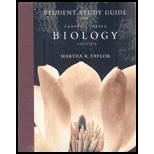
Concept explainers
To explain: The orientation of leaf works best in bright sunny conditions and low lightlevels.
Introduction: A leaf is a flat lateral structure and generally green in color that protrudes from the stem of plants to collect the sunlight for the process of photosynthesis. The leaf is the region where transpiration occurs. Thus, the leaf is an absolutely significant portion of any vascular plant for the processes of photosynthesis and transpiration.
Explanation of Solution
The leaves in plants are not at the same angle to the sunlight. Some of the leaves are vertical and some are horizontal and some found in between. The orientation of the leaf in some species of plant is altered throughout the day. The vertical orientation of the leaf works best in the bright sunny conditions because it would shield the leaves from extremely high intensity of light. It permits the sunlight to enter the leaves that are found in lower levels. The horizontal leaf orientation works best at the low intensities of light. The sunlight exposure is maximized by the horizontal orientation of the leaf.
To explain: The greater productivity in the low leaf area index or high leaf area index.
Explanation of Solution
Leaf depth layer in the community of plant will affect productivity. The leaf area index is defined as the total region ratio of the top surface of the leaves to the region of the ground, which is covered by a crop or a plant. The productivity of the plant rises with an increasing leaf area index as extra as areas of the leaf is obtainable to capture sunlight. When the leaf area index is too deep or high, then both leaves and lower branches are also shaped to the process of photosynthesizing. The plants with nonproductive lower leaves may die by the process called as self-pruning.
To explain: The physiology change and roots branching in response to the patches of nutrients such as nitrate.
Explanation of Solution
The roots are one of the organs present in the vascular plants, which generally lie below the soil surface. In roots, the branching pattern can give rise to take benefits of the local nitrate availability. Thus, it can help in the generation of nutrient transporters inside the cells of roots.
Want to see more full solutions like this?
Chapter 36 Solutions
Biology - Study Guide
- The mature regions of roots are relatively impermeable to water. Why? Explain its importance.arrow_forwardWhy are some roots called adventitious roots? What root system best adapted for anchorage? Why do you say so? Which among the root system is most advantageous to the plant? Explain your answer.arrow_forwardWhy root pressure is seen only under favorable conditions,like spring and rainy season?arrow_forward
- How do air bubbles form in the xylem and how are they eliminated to have a smooth transport of water in xylem?arrow_forwardWhy is the secondary xylem and phloem always to either side of the vascular cambium and is the primary xylem pushed inwardly by the secondary tissues? How about the primary phloem, cortex and epidermis, are they pushed outward by the secondary tissues?arrow_forwardBecause secondary phloem is formed from the vascular cambium just as secondary xylem is, it too has an __________________________ system and a _____________________ system. Why do the size, shape, and number of phloem rays match those of xylem rays?arrow_forward
- Choose the incorrect statement: a. Bundle sheath cells surround the vascular bundles in both eudicots and monocots. b. Phloem sieve elements contain a higher concentration of amino acids than xylem vessels. c. Phloem sieve elements and xylem tracheary elements are similar at maturity because they are both dead. d. Root hairs are the primary cell type that absorbs water in roots.arrow_forwardWhy roots bend towards the source of water?arrow_forwardRanunculus root (Root anatomy) Explain the functions of each of the tissues in the root (primary xylem, primary pollen, cortex, epidermis). What are the similarities and differences between the anatomy of the root vs that of the stem?arrow_forward

 Biology (MindTap Course List)BiologyISBN:9781337392938Author:Eldra Solomon, Charles Martin, Diana W. Martin, Linda R. BergPublisher:Cengage Learning
Biology (MindTap Course List)BiologyISBN:9781337392938Author:Eldra Solomon, Charles Martin, Diana W. Martin, Linda R. BergPublisher:Cengage Learning

